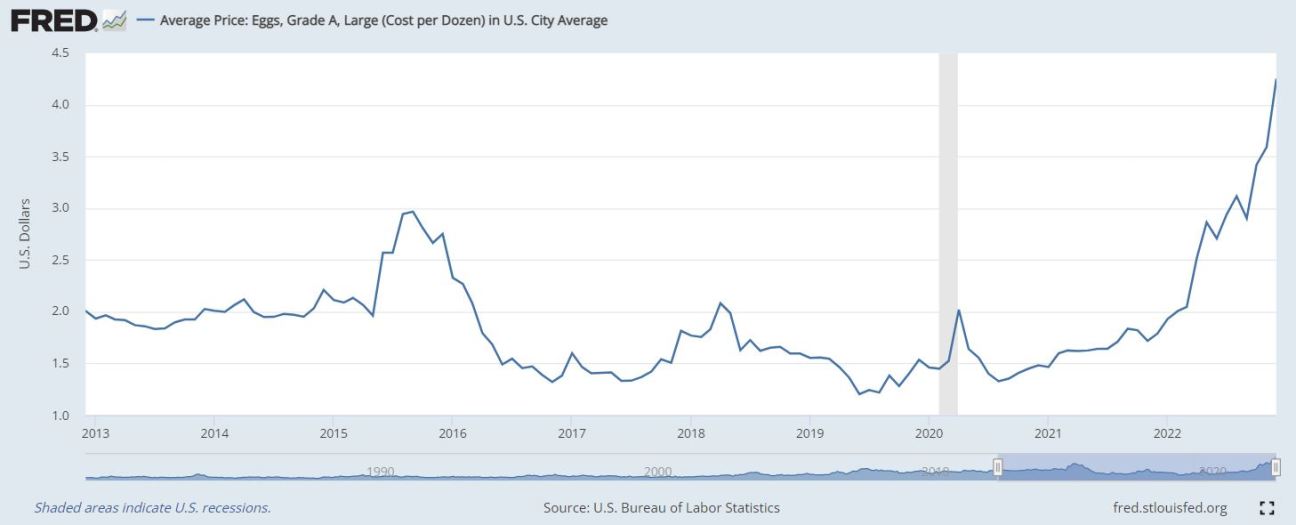A farmer-advocacy organization says record-breaking increases in the price of eggs isn’t being caused by inflation or avian flu, as claimed by egg companies, but by price collusion among the nation’s top egg producers.

A farmer-advocacy organization says record-breaking increases in the price of eggs isn’t being caused by inflation or avian flu, as claimed by egg companies, but by price collusion among the nation’s top egg producers.
In a letter sent to the Federal Trade Commission (FTC) last week, the organization Farm Action accused the country’s dominant egg producers of scheming to raise prices.
“The real culprit behind this 138% hike in the price of a carton of eggs appears to be a collusive scheme among industry leaders to turn inflationary conditions and an avian flu outbreak into an opportunity to extract egregious profits reaching as high as 40%,” read the Farm Action letter to the FTC.
The average price of a dozen eggs jumped from $1.79 in December 2021 to $4.25 in December 2022. To explain the increase, industry leaders have cited inflation plus the avian flu outbreak, which began in February 2022 and has killed more than 43 million commercial egg-laying hens, according to USDA data.
The avian flu outbreak in 2015 was deadlier but did not produce price spikes as high as those seen in 2022. The 2015 outbreak killed about 12% of the egg-laying hens in the U.S. Most of the 50 million birds that died were egg-laying hens and turkeys, according to the U.S. Department of Agriculture’s Economic Research Service (ERS).
During the 2015 outbreak, the average price of a dozen Grade A eggs doubled, from $1.29 to $2.61, according to the ERS.
During the current avian flu outbreak, average egg prices have nearly tripled.

Prices roughly doubled in 2015 during the nation’s deadliest outbreak of avian flu. During the current outbreak, prices have tripled. (St. Louis Fed)
Egg production has become a more vertically integrated industry over the past 45 years, according to the Agricultural Marketing Resource Center, a USDA-funded program based at Iowa State University. Vertical integration means different companies have merged to control multiple stages of the egg production process.
The largest egg producer in the United States, Cal-Maine Foods, has come to dominate the egg industry through the acquisition of other egg farms across the country, according to their website.
Critics of vertical integration say it has made the egg market less competitive, allowing big companies to coordinate pricing.
“If our market was truly competitive and working the way it’s supposed to work, then if one dominant firm tries to raise their price, another firm should try to take their market share,” said Sarah Carden, senior policy advocate at Farm Action, in an interview with the Daily Yonder.
“But instead what we see is all of them raising their prices,” Carden said.
Cal-Maine’s gross profit jumped 10-fold from one 26-week period in 2021 to the same period in 2022, according to the company’s most recent quarterly financial statement. For the 26-week fiscal period ending in November 2021, gross profits were $50.4 million. In 2022 for the same period, gross profits were $535.3 million.
From the first quarter of 2022 to the last, the company’s margins grew more than three-fold, according to Farm Action.
“To increase your gross margins by 345% from the year before while consumers are looking at at least doubled egg prices – I mean, that’s just theft,” Carden said.
Cal-Maine also sold more eggs during the last 26-week period of 2022 than in the same period of 2021: 559.4 million eggs by the dozen sold compared to 524.2 million eggs by the dozen.
“We see big agriculture controlling this narrative about avian flu and supply chain issues,” Carden said. “But when you block out all that noise and just look at the numbers… there’s not a substantial decrease in [egg] supply.”
A spokesperson for the American Egg Board said that supply and demand set egg prices, not farmers.
“Eggs are bought and sold on the commodity market, where farmers don’t set the price of eggs – the market does,” a representative wrote in an email to the Daily Yonder.
Farm Action is urging the FTC to investigate Cal-Maine and the nation’s other largest egg producers (Rose Acre Farms, Versova Holdings L.L.P., Hillandale Farms, and Daybreak Foods) for “anti-competitive arrangements that suppress competition among egg producers.”
This article first appeared on The Daily Yonder and is republished here under a Creative Commons license.
Egg-laying hens are the latest Daraprim scam. Wheat and rice are next. (Sips tea).
The staggering profits reported by egg producers amid skyrocketing prices raise serious concerns about potential price gouging. In a time when families struggle to afford basic groceries, such disproportionate earnings suggest exploitation of market dynamics, warranting immediate investigation to protect consumers from unfair pricing practices.
As egg profits soar, concerns about potential price gouging are on the rise. Amidst these challenges, businesses are turning to innovative solutions like Priceva’s competitor price tracking and monitoring software. This tool, highlighted at Priceva, offers automated tracking and immediate notifications of price changes, enabling businesses to stay competitive without resorting to unethical practices. With a single interface for managing all metrics and comprehensive analytics, businesses can uncover market opportunities efficiently. Moreover, Priceva’s AI-based repricing tool helps in formulating strategies that are ethical and market-friendly, ensuring a balanced approach to pricing in an increasingly dynamic market.